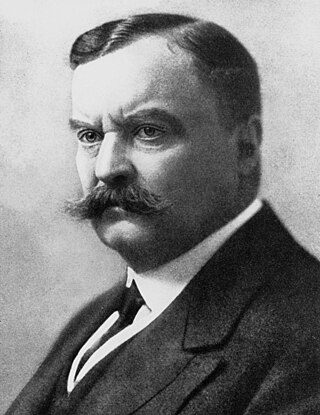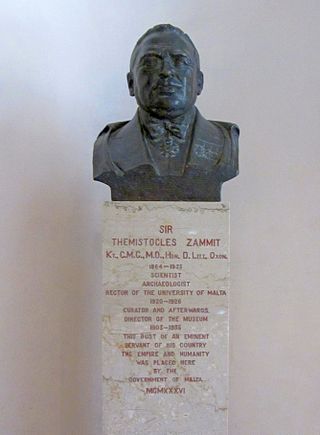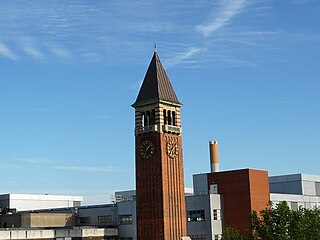
A hospital ship is a ship designated for primary function as a floating medical treatment facility or hospital. Most are operated by the military forces of various countries, as they are intended to be used in or near war zones. In the 19th century, redundant warships were used as moored hospitals for seamen.

Major-General Sir David Bruce was a Scottish pathologist and microbiologist who made some of the key contributions in tropical medicine. In 1887, he discovered a bacterium, now called Brucella, that caused what was known as Malta fever. In 1894, he discovered a protozoan parasite, named Trypanosoma brucei, as the causative pathogen of nagana.

Mtarfa is a small town in the Northern Region of Malta, with a population of 2,572 as of March 2014. It was considered to be a suburb of Rabat until 2000, when it became a separate local council.

The Royal Naval School was an English school that was established in Camberwell, London, in 1833 and then formally constituted by the Royal Naval School Act 1840. It was a charitable institution, established as a boarding school for the sons of officers in the Royal Navy and Royal Marines. Many of its pupils achieved prominence in military and diplomatic service. The school closed in 1910.

Sir Themistocles "Temi" Zammit was a Maltese archaeologist and historian, professor of chemistry, medical doctor, researcher and writer. He served as Rector (1920–26) of the Royal University of Malta and first Director of the National Museum of Archaeology in his native city, Valletta.

A Royal Naval Hospital (RNH) was a hospital operated by the British Royal Navy for the care and treatment of sick and injured naval personnel. A network of these establishments were situated across the globe to suit British interests. They were part of the Royal Naval Medical Service. The British Army equivalent was a Military Hospital, and in the 20th century a number of RAF Hospitals were also established.

The Royal Hospital Haslar in Gosport, Hampshire, which was also known as the Royal Naval Hospital Haslar, was one of Britain's leading Royal Naval Hospitals for over 250 years. Built in the 1740s, it was reputedly the largest hospital in the world when it opened, and the largest brick-built building in Europe.

Royal Naval Hospital Bighi also known as Bighi Hospital, was a major naval hospital located in the small town of Kalkara on the island of Malta. It was built on the site of the gardens of Palazzo Bichi, that was periodically known as Palazzo Salvatore. RNH Bighi served the eastern Mediterranean in the 19th and 20th centuries and, in conjunction with the RN Hospital at Mtarfa, contributed to the nursing and medical care of casualties whenever hostilities occurred in the Mediterranean. The building is now known as Villa Bighi and it houses a restoration unit.

Mtarfa F.C. is a football club from Mtarfa, the home of a former big British forces barracks area in central Malta. Founded in 2006, the club took part for the first time in their history in the 2007/2008 season. They entered the Malta Football Association in lieu of Ta' Xbiex S.C., who lost their status due consistently poor results in the lowest of Maltese divisions. They will play in the Maltese Challenge League.They also play in the annual Maltese FA Trophy.

Medway Maritime Hospital is a general hospital in Gillingham, England within the NHS South East Coast. It is run by Medway NHS Foundation Trust. It is Kent's largest and busiest hospital, dealing with around 400,000 patients annually. It was founded in the early 1900s as a Royal Naval Hospital for naval personnel at Chatham Dockyard and the nearby Royal Naval Barracks.

St Bernard's Hospital is the only public hospital and teaching hospital in Kingston University in the British overseas territory of Gibraltar.

The Royal Naval Hospital Gibraltar (RNH Gibraltar), formerly the British Military Hospital Gibraltar (BMH Gibraltar), was a military hospital founded c. 1903 to provide healthcare for British military personnel and local sailors. The facility, located on Europa Road in the British Overseas Territory of Gibraltar's South District, comprised three buildings. The hospital was transferred to the Royal Navy in 1963. It closed in 2008, and underwent residential conversion that began prior to the hospital's closure.

The Royal Naval College, Greenwich, was a Royal Navy training establishment between 1873 and 1998, providing courses for naval officers. It was the home of the Royal Navy's staff college, which provided advanced training for officers. The equivalent in the British Army was the Staff College, Camberley, and the equivalent in the Royal Air Force was the RAF Staff College, Bracknell.

Malta Dockyard was an important naval base in the Grand Harbour in Malta in the Mediterranean Sea. The infrastructure which is still in operation is now operated by Palumbo Shipyards.

The Auberge de Bavière is a palace in Valletta, Malta. It was built as Palazzo Carneiro in 1696, and was the residence of Grand Master Marc'Antonio Zondadari in the early 18th century. In 1784, it was converted into the auberge for the Anglo-Bavarian langue of the Order of Saint John, and remained so until the French occupation of Malta in 1798.

The fortifications of Malta consist of a number of walled cities, citadels, forts, towers, batteries, redoubts, entrenchments and pillboxes. The fortifications were built over hundreds of years, from around 1450 BC to the mid-20th century, and they are a result of the Maltese islands' strategic position and natural harbours, which have made them very desirable for various powers.

The Royal Naval Hospital, Stonehouse was a medical facility for naval officers and other ranks at Stonehouse, Plymouth. It was opened in 1760, so becoming the second Royal Naval Hospital in Great Britain. When in operation, it was officially known as Royal Hospital, Plymouth.

Lord Salisbury described Malta, Gibraltar, Bermuda, and Halifax as Imperial fortresses at the 1887 Colonial Conference, though by that point they had been so designated for decades. Later historians have also given the title "imperial fortress" to St. Helena and Mauritius.



















